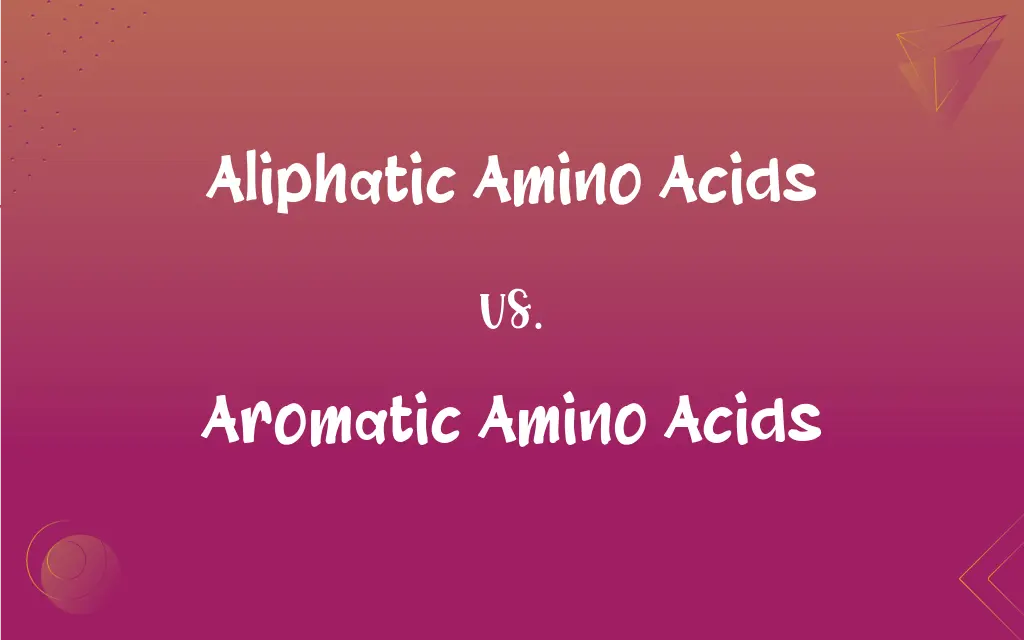Aliphatic Amino Acids vs. Aromatic Amino Acids: What's the Difference?
By Janet White || Published on March 2, 2024
Aliphatic amino acids have straight or branched chains, while aromatic amino acids contain a benzene ring, influencing properties and functions.

Key Differences
Aliphatic amino acids are characterized by their straight or branched carbon chains, making them hydrophobic and essential in protein structure, while aromatic amino acids contain one or more benzene rings, contributing to protein stability through π-π interactions.
Aliphatic amino acids, such as valine, leucine, and isoleucine, are critical for maintaining the hydrophobic core of proteins, whereas aromatic amino acids like phenylalanine, tyrosine, and tryptophan are involved in protein interactions and signal transduction due to their ability to absorb UV light.
The simplicity of aliphatic amino acids' structure allows them a wide range of functions in proteins, including roles in enzyme active sites and structural components, whereas the complexity of aromatic amino acids gives them unique roles in biological processes such as neurotransmitter synthesis.
The nonpolar nature of aliphatic amino acids makes them key in forming the hydrophobic interactions necessary for protein folding, contrasting with the more chemically reactive aromatic amino acids, which participate in electron transfer and serve as docking sites for ligand binding.
Aliphatic amino acids are prevalent in the inner regions of proteins, minimizing water interactions, while aromatic amino acids often occur at protein surfaces or active sites, engaging in specific interactions critical for protein function.
ADVERTISEMENT
Comparison Chart
Structure
Straight or branched chains
Contains benzene rings
Hydrophobicity
Generally more hydrophobic
Less hydrophobic due to ring structures
UV Absorbance
Do not absorb UV light
Absorb UV light, useful in protein characterization
Role in Proteins
Structural, influence folding
Functional, involved in interactions
Examples
Valine, Leucine, Isoleucine
Phenylalanine, Tyrosine, Tryptophan
ADVERTISEMENT
Aliphatic Amino Acids and Aromatic Amino Acids Definitions
Aliphatic Amino Acids
Often found in the interior of protein molecules.
Aliphatic amino acids contribute to the hydrophobic interior of proteins.
Aromatic Amino Acids
Essential for the catalytic activity of certain enzymes.
Enzymes often require aromatic amino acids at their active sites for function.
Aliphatic Amino Acids
Simple in structure, key in protein architecture.
Aliphatic amino acids like leucine are crucial for protein stability.
Aromatic Amino Acids
Play a role in signal transduction and neurotransmitter synthesis.
Aromatic amino acids like tyrosine are precursors to important neurotransmitters.
Aliphatic Amino Acids
Characterized by nonpolar side chains, promoting hydrophobic interactions.
The hydrophobic core of many proteins is rich in aliphatic amino acids.
Aromatic Amino Acids
Involved in protein-protein interactions due to their unique structures.
Phenylalanine's aromatic ring is crucial for binding specific ligands.
Aliphatic Amino Acids
Essential for maintaining protein structure and function.
Valine, an aliphatic amino acid, is vital for muscle metabolism.
Aromatic Amino Acids
Can absorb ultraviolet light, aiding in protein analysis.
Tyrosine's absorption of UV light is useful in studying protein concentrations.
Aliphatic Amino Acids
Include essential amino acids not synthesized by the body.
Essential aliphatic amino acids like isoleucine must be obtained through diet.
Aromatic Amino Acids
Contain benzene rings, contributing to protein functionality.
Tryptophan, an aromatic amino acid, plays a role in serotonin synthesis.
FAQs
What role do aliphatic amino acids play in protein structure?
They help form the hydrophobic core, influencing protein folding.
Are all aliphatic amino acids essential?
Not all, but some like leucine and isoleucine are essential.
How do aromatic amino acids participate in biological processes?
They're involved in signal transduction and neurotransmitter synthesis.
How do aliphatic amino acids influence protein solubility?
Their hydrophobic nature can decrease protein solubility in water.
What distinguishes aliphatic amino acids from aromatic amino acids?
Aliphatic amino acids have simple chains, while aromatic ones have benzene rings.
Are aliphatic amino acids hydrophobic or hydrophilic?
They are generally hydrophobic due to their nonpolar side chains.
Can aliphatic amino acids absorb UV light?
No, unlike aromatic amino acids, they do not absorb UV light.
Why are aromatic amino acids important in proteins?
They contribute to protein stability and function through unique interactions.
How are aliphatic amino acids involved in metabolic processes?
They serve as precursors for various metabolites and bioactive molecules.
What makes aromatic amino acids unique in protein analysis?
Their ability to absorb UV light makes them useful in spectrophotometric analyses.
What determines the essentiality of aliphatic amino acids?
The body's inability to synthesize them, necessitating dietary intake.
How do aromatic amino acids affect protein-protein interactions?
Their benzene rings facilitate specific binding and interaction sites.
Are aliphatic amino acids found more in the interior or exterior of proteins?
They are more commonly found in the interior due to their hydrophobicity.
Do aromatic amino acids have any role in enzyme catalysis?
Yes, they often participate in enzyme active sites and catalysis.
Can aromatic amino acids act as neurotransmitter precursors?
Yes, tyrosine and tryptophan are precursors to dopamine and serotonin.
Do aliphatic amino acids participate in signal transduction pathways?
Indirectly, by influencing protein structure and interaction capabilities.
How do dietary needs differ for aliphatic and aromatic amino acids?
Both types are required, but essential amino acids must be obtained through diet.
What is the impact of the aromatic ring on the chemical reactivity of amino acids?
It increases their reactivity, allowing for diverse functional roles in proteins.
What is the significance of the benzene ring in aromatic amino acids?
It allows for π-π interactions and absorption of UV light.
What is the role of aromatic amino acids in UV spectrophotometry?
They enable the measurement of protein concentrations using UV absorption.
About Author
Written by
Janet WhiteJanet White has been an esteemed writer and blogger for Difference Wiki. Holding a Master's degree in Science and Medical Journalism from the prestigious Boston University, she has consistently demonstrated her expertise and passion for her field. When she's not immersed in her work, Janet relishes her time exercising, delving into a good book, and cherishing moments with friends and family.
































































